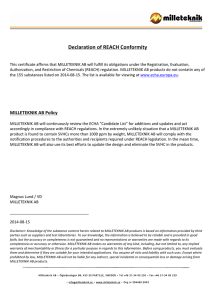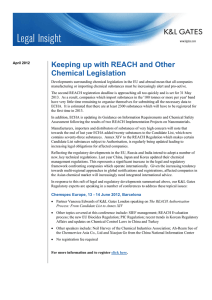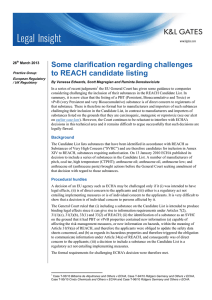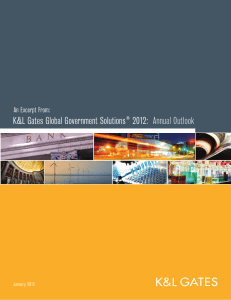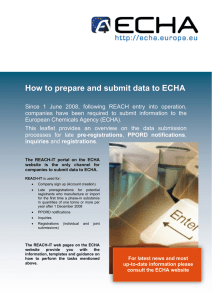Challenging ECHA Decisions
advertisement
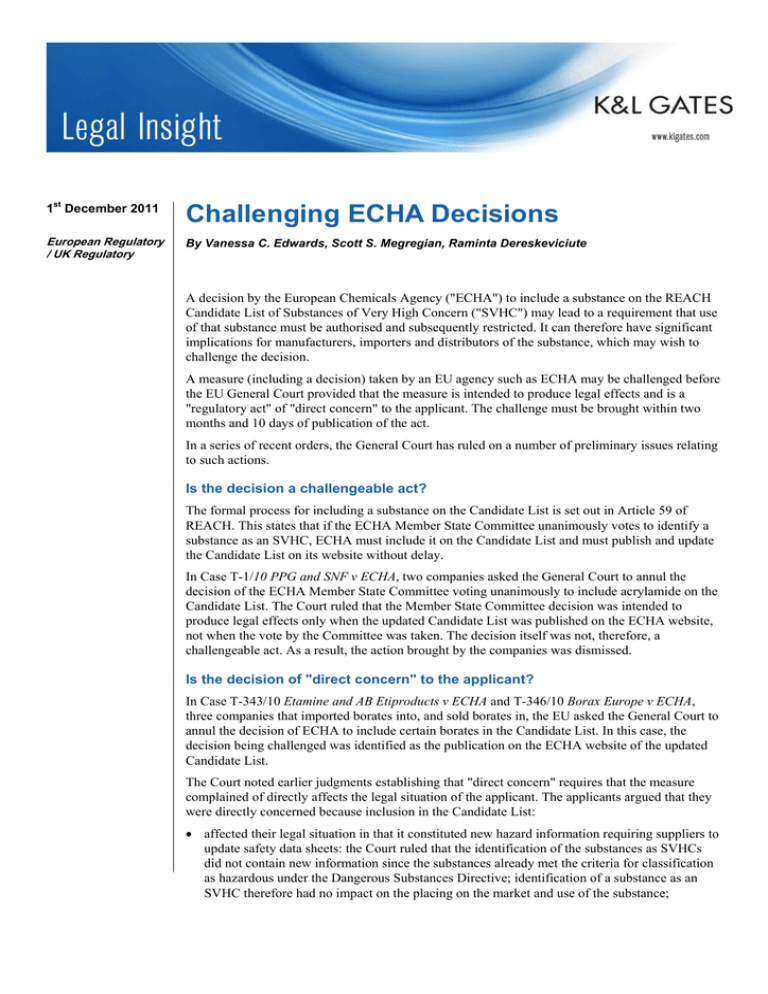
1st December 2011 Challenging ECHA Decisions European Regulatory / UK Regulatory By Vanessa C. Edwards, Scott S. Megregian, Raminta Dereskeviciute A decision by the European Chemicals Agency ("ECHA") to include a substance on the REACH Candidate List of Substances of Very High Concern ("SVHC") may lead to a requirement that use of that substance must be authorised and subsequently restricted. It can therefore have significant implications for manufacturers, importers and distributors of the substance, which may wish to challenge the decision. A measure (including a decision) taken by an EU agency such as ECHA may be challenged before the EU General Court provided that the measure is intended to produce legal effects and is a "regulatory act" of "direct concern" to the applicant. The challenge must be brought within two months and 10 days of publication of the act. In a series of recent orders, the General Court has ruled on a number of preliminary issues relating to such actions. Is the decision a challengeable act? The formal process for including a substance on the Candidate List is set out in Article 59 of REACH. This states that if the ECHA Member State Committee unanimously votes to identify a substance as an SVHC, ECHA must include it on the Candidate List and must publish and update the Candidate List on its website without delay. In Case T-1/10 PPG and SNF v ECHA, two companies asked the General Court to annul the decision of the ECHA Member State Committee voting unanimously to include acrylamide on the Candidate List. The Court ruled that the Member State Committee decision was intended to produce legal effects only when the updated Candidate List was published on the ECHA website, not when the vote by the Committee was taken. The decision itself was not, therefore, a challengeable act. As a result, the action brought by the companies was dismissed. Is the decision of "direct concern" to the applicant? In Case T-343/10 Etamine and AB Etiproducts v ECHA and T-346/10 Borax Europe v ECHA, three companies that imported borates into, and sold borates in, the EU asked the General Court to annul the decision of ECHA to include certain borates in the Candidate List. In this case, the decision being challenged was identified as the publication on the ECHA website of the updated Candidate List. The Court noted earlier judgments establishing that "direct concern" requires that the measure complained of directly affects the legal situation of the applicant. The applicants argued that they were directly concerned because inclusion in the Candidate List: affected their legal situation in that it constituted new hazard information requiring suppliers to update safety data sheets: the Court ruled that the identification of the substances as SVHCs did not contain new information since the substances already met the criteria for classification as hazardous under the Dangerous Substances Directive; identification of a substance as an SVHC therefore had no impact on the placing on the market and use of the substance; Challenging ECHA Decisions triggered the obligation in Article 34(a) of REACH to communicate new information on hazardous properties up the supply chain: the Court ruled that Article 34(a) did not impose requirements on the applicants as it only imposed obligations up the supply chain and in any event the identification of the substances as SVHCs did not include new information on hazardous properties; triggered the obligation in Article 7(2) and 33 of REACH to notify and communicate information concerning SVHCs in articles: the Court ruled that those provisions were not of concern to the applicants as they were importers and sellers of substances and not producers, importers or suppliers of articles; affected their material situation in that their customers would be reluctant to continue to buy products containing substances on the Candidate List: the Court ruled that the applicants had merely claimed, and not proven, this. Timing an Application In Case T-268/10 PPG and SNF v ECHA, the applicants made a separate application on 10 June 2010 challenging the inclusion of acrylamide in the Candidate List, which had been published on the ECHA website on 30 March 2010. ECHA and the Commission argued that the challenge had been brought more than two months and 10 days after publication and was therefore out of time. The applicants referred to the General Court's Rules of Procedure, which provided that the time limit started from the end of the 14th day following publication of the contested decision. The Court ruled that that provision applied only (as it clearly stated) to acts published in the Official Journal of the EU. Since Article 59 of REACH requires publication of the Candidate List on the ECHA website only and not in the Official Journal of the EU, the extra 14 days do not apply when inclusion of substances in the Candidate List is being challenged. Implications Manufacturers and importers of substances added to the Candidate List may be understandably eager to seek annulment of ECHA's decision to that effect. However, these recent cases demonstrate that an ill-considered challenge risks being dismissed at an early stage on procedural grounds. To maximise the chances of success, the following must be borne in mind: First, it is essential to identify the correct measure to challenge, namely the measure that is intended to produce legal effects. The decision of the ECHA Member State Committee voting to identify a substance as an SVHC is not such a measure; in contrast, inclusion of a substance on the Candidate List is intended to produce legal effects and may in principal be challenged. Second, demonstrating that inclusion of a substance on the Candidate List is of "direct concern" to a manufacturer or importer of the substance will be difficult. However, the General Court's reasoning in dismissing the applicants' arguments on this point nonetheless gives some guidance as to how a challenge may be drafted with the best chance of meeting this condition. Third, an action for annulment of a decision by ECHA to include a substance on the Candidate List must be brought within two months and 10 days of publication of the updated Candidate List on the ECHA website. Finally, the applicants in the cases discussed above have the right to appeal to the EU Court of Justice against the orders of the EU General Court. We have not yet heard whether any of the applicants has decided to appeal, but it may be that the above decisions will be reviewed by a higher court and possibly reversed. 2 Challenging ECHA Decisions Please contact the K&L Gates REACH team if your company / industry is considering challenging any REACH/CLP decision taken by ECHA or by the European Commission. Authors: Vanessa C. Edwards vanessa.edwards@klgates.com +44.(0)20.7360.8293 Scott S. Megregian scott.megregian@klgates.com +44.(0)20.7360.8110 Raminta Dereskeviciute raminta.dereskeviciute@klgates.com +44.(0)20.7360.8264 3
